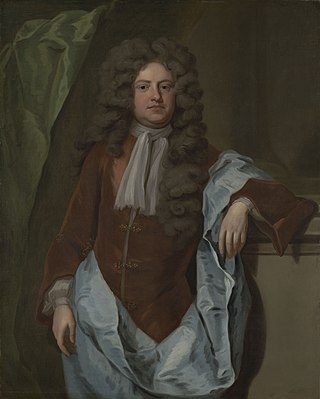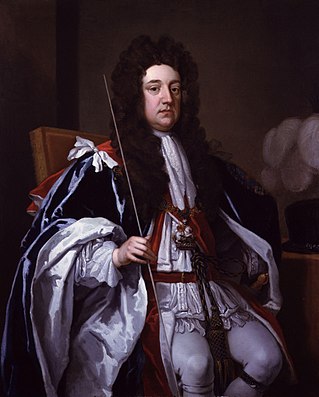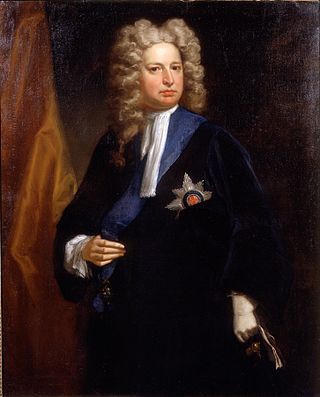History
Somers, Wharton, Russell and Montagu were elected to the House of Commons in 1689 [4] and were granted minor office. Their effectiveness in the Commons brought them Sunderland's attention. The Junto began to dominate the ministry from the time of the resignation of the Tory Secretary of State Lord Nottingham in 1693, [5] communicating to the King and Sunderland through the Whig Secretary of State, the Duke of Shrewsbury. As the members of the Junto entered the Lords — Somers was made Lord Keeper in 1693 [6] and was promoted to a barony four years later, [7] Wharton succeeded his father as Baron Wharton in 1696, [8] Russell was created Earl of Orford in 1697 [9] and Montagu(e) [n 1] was created Baron Halifax in 1700 — their hold on the Commons weakened and by 1700 the Junto was largely out of power. [10] In 1701 Somers, Orford and Halifax were impeached but survived the attack [11] and late in the year the Junto seemed set to return to power in order to help the king rally support for the War of the Spanish Succession.
However, King William's death in March 1702 delayed their return: Queen Anne detested them and refused to include them in the ministry, which was instead dominated by High Tories, with whom her sympathies lay. [12] With the elder Sunderland dead, the Junto's connection to his son — who was the son-in-law of the Queen's favourite couple, the Duke and Duchess of Marlborough — proved useful, as did the Junto's support of the war, which contrasted with Tory ambivalence to it.
In 1705 Somers's protégé Lord Cowper, whom the Queen liked and trusted, was made Lord Keeper [13] and in 1706 Sunderland became a Secretary of State, even though the Queen disliked him even more than she did the rest of the Junto. [14] After the resignation of Harley in 1708, Marlborough and his ally the Lord Treasurer Godolphin became more and more dependent on the Junto, who returned to office with Somers as Lord President, Wharton as Lord Lieutenant of Ireland and Orford as First Lord of the Admiralty. [15]
The ministry's increasing dependence on the Junto Whigs caused the Queen's relationship with the Marlboroughs and Godolphin to sour. In 1710 Godolphin and the Junto Whigs were forced from power. [16] The Junto led opposition to the new ministry's peace policy from the House of Lords, leading to the creation of new peers to prevent this opposition from voting down the peace treaty. [17]
In North America, the Whig Junto was the inspiration for Benjamin Franklin's Junto in 1727 Philadelphia upon his return from London. [18]
The term "Junto", first attested in 1641, is derived from "junta", a Hispano-Portuguese term for a civil deliberative or administrative council, [19] which in 18th-century English had not yet gained its present association with the governments of a military dictatorship. The form "juncto" (after Latin junctum) was also used until about 1700.
The Whigs were a political faction and then a political party in the Parliaments of England, Scotland, Ireland, Great Britain, and the United Kingdom. Between the 1680s and the 1850s, the Whigs contested power with their rivals, the Tories. The Whigs merged into the Liberal Party with the Peelites and Radicals in the 1850s. Many Whigs left the Liberal Party in 1886 to form the Liberal Unionist Party, which merged into the Conservative Party in 1912.

Anne was Queen of Great Britain and Ireland following the ratification of the Acts of Union on 1 May 1707, which merged the kingdoms of Scotland and England. Previous to this, she was Queen of England, Scotland, and Ireland from 8 March 1702.

Charles Montagu, 1st Earl of Halifax,, was an English statesman and poet. He was the grandson of the 1st Earl of Manchester and was eventually ennobled himself, first as Baron Halifax in 1700 and later as Earl of Halifax in 1714. As one of the three members of the so-called Whig Junto, Montagu played a major role in English politics under the reigns of King William III and Queen Anne. He served as Chancellor of the Exchequer from 1694 to 1699 and as First Lord of the Treasury from 1714 until his death the following year. He was also president of the Royal Society and a patron of the scientist Isaac Newton.

General John Churchill, 1st Duke of Marlborough, 1st Prince of Mindelheim, 1st Count of Nellenburg, Prince of the Holy Roman Empire, was an English soldier and statesman. From a gentry family, he served first as a page at the court of the House of Stuart under James, Duke of York, through the 1670s and early 1680s, earning military and political advancement through his courage and diplomatic skill. He is known for never having lost a battle.

Charles Spencer, 3rd Earl of Sunderland, KG, PC, known as Lord Spencer from 1688 to 1702, was an English statesman and nobleman from the Spencer family. He served as Lord Lieutenant of Ireland (1714–1717), Lord Privy Seal (1715–1716), Lord President of the Council (1718–1719) and First Lord of the Treasury (1718–1721).

Sidney Godolphin, 1st Earl of Godolphin, was an English Tory politician and peer. He was a Privy Councillor and Secretary of State for the Northern Department before he attained real power as First Lord of the Treasury. He was instrumental in negotiating and passing the Acts of Union 1707 with Scotland, which created the Kingdom of Great Britain. He had many other roles, including that of Governor of Scilly.

Prince George of Denmark and Norway was the husband of Anne, Queen of Great Britain. He was the consort of the British monarch from Anne's accession on 8 March 1702 until his death in 1708.

Robert Harley, 1st Earl of Oxford and Earl Mortimer, KG PC FRS was an English statesman and peer of the late Stuart and early Georgian periods. He began his career as a Whig, before defecting to a new Tory ministry. He was raised to the peerage of Great Britain as an earl in 1711. Between 1711 and 1714 he served as Lord High Treasurer, effectively Queen Anne's chief minister. He has been called a prime minister, although it is generally accepted that the de facto first minister to be a prime minister was Robert Walpole in 1721.
The Tories were a loosely organised political faction and later a political party, in the Parliaments of England, Scotland, Ireland, Great Britain and the United Kingdom. They first emerged during the 1679 Exclusion Crisis, when they opposed Whig efforts to exclude James, Duke of York from the succession on the grounds of his Catholicism. Despite their fervent opposition to state-sponsored Catholicism, Tories opposed exclusion in the belief inheritance based on birth was the foundation of a stable society.

Sir Nathan Wright (1654–1721) was an English judge, Lord Keeper of the Great Seal under King William III and Queen Anne. He offended the House of Commons by his use of habeas corpus in 1704, and lost office in 1705.

Admiral of the Fleet Edward Russell, 1st Earl of Orford, PC was a Royal Navy officer and politician. After serving as a junior officer at the Battle of Solebay during the Third Anglo-Dutch War, he served as a captain in the Mediterranean Sea in operations against the Barbary pirates.

This is a list of the principal Ministers of the Crown of the Kingdom of England, and then of the Kingdom of Great Britain, from May 1702, at the beginning of the reign of Queen Anne. During this period, the leaders of the ministry were Lord Godolphin and the Duke of Marlborough.
The First Whig Junto controlled the government of England from 1694 to 1699 and was the first part of the Whig Junto, a cabal of people who controlled the most important political decisions. The Junto was reappointed twice following the elections of 1695 and 1698.

Thomas Wharton, 1st Marquess of Wharton, PC was an English peer and Whig politician. A man of great charm and political ability, he was also notorious for his debauched lifestyle.

The first Parliament of the Kingdom of Great Britain was established in 1707 after the merger of the Kingdom of England and the Kingdom of Scotland. It was in fact the 4th and last session of the 2nd Parliament of Queen Anne suitably renamed: no fresh elections were held in England or in Wales, and the existing members of the House of Commons of England sat as members of the new House of Commons of Great Britain. In Scotland, prior to the union coming into effect, the Scottish Parliament appointed sixteen peers and 45 Members of Parliaments to join their English counterparts at Westminster.

The 2nd Parliament of Great Britain was the first British Parliament to actually be elected, as the 1st Parliament of Great Britain had been drawn from the former Parliament of England and Parliament of Scotland.

The Harleyministry was the British government that existed between 1710 and 1714 in the reign of Queen Anne. It was headed by Robert Harley and composed largely of Tories. Harley was a former Whig who had changed sides, bringing down the seemingly powerful Whig Junto and their moderate Tory ally Lord Godolphin. It came during the Rage of Party when divisions between the two factions were at their height, and a "paper war" broke out between their supporters. Amongst those writers supportive of Harley's government were Jonathan Swift, Daniel Defoe, Delarivier Manley, John Arbuthnot and Alexander Pope who clashed with members of the rival Kit-Kat Club.
Robert Monckton was an English landowner and Whig politician who sat in the English and British House of Commons between 1695 and 1713. He took an active part supporting William of Orange in the Glorious Revolution, and was notable for his involvement in a number of exceptionally bitter and prolonged electoral disputes.

The 4th Parliament of William III was summoned by William III of England on 13 July 1698 and assembled on 24 August 1698. The party political constitution of the new House of Commons was 246 Whigs, 208 Tories and 59 others. Sir Thomas Littleton, the Whig member for Woodstock, was elected Speaker of the House. The house was divided between the pro-government faction led by the Whig Junto and a Country Whig-Tory alliance, the New Country party, led by Robert Harley.

The 5th Parliament of William III was summoned by William III of England on 26 December 1700 and assembled on 6 February 1701. The party political constitution of the new House of Commons was 249 Tories, 219 Whigs and 45 others, representing a significant swing in favour of the Tories. Robert Harley, the Tory member for Radnor, who had declined a post in William III's new ministry, was elected Speaker of the House.


















